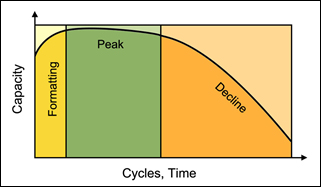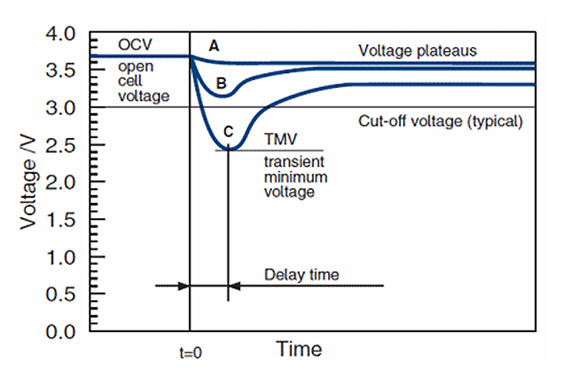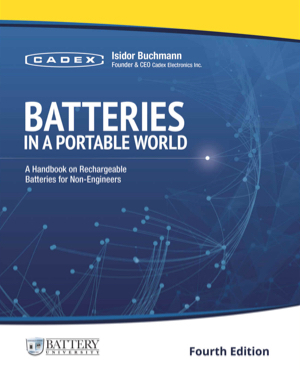In many ways, a battery behaves like a human being. It senses the kindness given and delivers on the care given. It is as if the battery has feelings and returns on the benevolence bestowed. But there are exceptions, as any parent raising a family will know; and the generosity conferred may not always deliver the anticipated returns.
To become a good custodian, you must understand the basic needs of a battery, a subject that is not taught in school. This section teaches what to do when the battery is new, how to feed it the right “food” and what to do when putting the pack aside for a while. Chapter 7 also looks into restrictions when traveling with batteries by air and how to dispose of them when their useful life has passed.
Just as a person’s life expectancy cannot be predicted at birth, neither can we date stamp a battery. Some packs live to a great old age while others die young. Incorrect charging, harsh discharge loads and exposure to heat are the battery’s worst enemies. Although there are ways to protect a battery, the ideal situation is not always attainable. This chapter discusses how to get the most from our batteries.
Priming a New Battery
Not all rechargeable batteries deliver the rated capacity when new, and they require formatting. While this applies to most battery systems, manufacturers of lithium-ion batteries disagree. They say that Li-ion is ready at birth and does not need priming. Although this may be true, users have reported some capacity gains by cycling after a long storage.
“What’s the difference between formatting and priming?” people ask. Both address capacities that are not optimized and can be improved with cycling. Formatting completes the fabrication process that occurs naturally during use when the battery is being cycled. A typical example is lead- and nickel-based batteries that improve with usage until fully formatted. Priming, on the other hand, is a conditioning cycle that is applied as a service to improve battery performance during usage or after prolonged storage. Priming relates mainly to nickel-based batteries.
Lead Acid
Formatting a lead acid battery occurs by applying a charge, followed by a discharge and recharge. This is done at the factory and is completed in the field as part of regular use. Experts advise not to strain a new battery by giving it heavy duty discharges at first but gradually working it in with moderate discharges, like an athlete trains for weight lifting or long-distance running. This, however, may not be possible with a starter battery in a vehicle and other uses. Lead acid typically reaches the full capacity potential after 50 to 100 cycles. Figure 1 illustrates the lifespan of lead acid.

A new lead acid battery may not by fully formatted and only attains full performance after 50 or more cycles. Formatting occurs during use; deliberate cycling is not recommended as this would wear down the battery unnecessarily.
Deep-cycle batteries are at about 85 percent when new and will increase to 100 percent, or close to full capacity, when fully formatted. There are some outliers that are as low as 65 percent when tested with a battery analyzer. The question is asked, “Will these low-performers recover and stand up to their stronger brothers when formatted?” A seasoned battery expert said that “these batteries will improve somewhat but they are the first to fail.”
The function of a starter battery lies in delivering high load currents to crank the engine, and this attribute is present from the beginning without the need to format and prime. To the surprise of many motorists, the capacity of a starter battery can fade to 30 percent and still crank the engine; however, a further drop may get the driver stranded one morning. See also BU-904: How to Measure Capacity)
Nickel-based
Manufacturers advise to trickle charge a nickel-based battery for 16–24 hours when new and after a long storage. This allows the cells to adjust to each other and to bring them to an equal charge level. A slow charge also helps to redistribute the electrolyte to eliminate dry spots on the separator that might have developed by gravitation.
Nickel-based batteries are not always fully formatted when leaving the factory. Applying several charge/discharge cycles through normal use or with a battery analyzer completes the formatting process. The number of cycles required to attain full capacity differs between cell manufacturers. Quality cells perform to specification after 5–7 cycles, while lower-cost alternatives may need 50 or more cycles to reach acceptable capacity levels.
Lack of formatting causes a problem when the user expects a new battery to work at full capacity out of the box. Organizations using batteries for mission-critical applications should verify the performance through a discharge/charge cycle as part of quality control. The “prime” program of automated battery analyzers (Cadex) applies as many cycles as needed to attain full capacity.
Cycling also restores lost capacity when a nickel-based battery has been stored for a few months. Storage time, state-of-charge and temperature under which the battery is stored govern the ease of recovery. The longer the storage and the warmer the temperature, the more cycles will be required to regain full capacity. Battery analyzers help in the priming functions and assure that the desired capacity has been achieved.
Lithium-ion
Some battery users insist that a passivation layer develops on the cathode of a lithium-ion cell after storage. Also known as interfacial protective film (IPF), this layer is said to restrict ion flow, cause an increase in internal resistance and in the worst case, lead to lithium plating. Charging, and more effectively cycling, is known to dissolve the layer and some battery users claim to have gained extra runtime after the second or third cycle on a smartphone, albeit by a small amount.
Scientists do not fully understand the nature of this layer, and the few published resources on this subject only speculate that performance restoration with cycling is connected to the removal of the passivation layer. Some scientists outright deny the existence of the IPF, saying that the idea is highly speculative and inconsistent with existing studies. Whatever the outcome on the passivation of Li-ion may be, there is no parallel to the “memory” effect with NiCd batteries that require periodic cycling to prevent capacity loss. The symptoms may appear similar but the mechanics are different. Nor can the effect be compared to sulfation of lead acid batteries.
A well-known layer that builds up on the anode is the solid electrolyte solid electrolyte interface (SEI). SEI is an electrical insulation but has sufficient ionic conductivity to allow the battery to function normally. While the SEI layer lowers the capacity, it also protects the battery. Without SEI, Li-ion might not get the longevity that it has. (See BU-307: How does Electrolyte Work?)
The SEI layer develops as part of a formation process and manufacturers take great care to do this right, as a batched job can cause permanent capacity loss and a rise in internal resistance. The process includes several cycles, float charges at elevated temperatures and rest periods that can take many weeks to complete. This formation period also provides quality control and assists in cell matching, as well as observing self-discharge by measuring the cell voltage after a rest. High self-discharge hints to impurity as part of a potential manufacturing defect.
Electrolyte oxidation (EO) also occurs on the cathode. This causes a permanent capacity loss and increases the internal resistance. No remedy exists to remove the layer once formed but electrolyte additives lessen the impact. Keeping Li-ion at a voltage above 4.10V/cell while at an elevated temperature promotes electrolyte oxidation. Field observation shows that the combination of heat and high voltage can stress Li-ion more than harsh cycling.
Lithium-ion is a very clean system that does not need additional priming once it leaves the factory, nor does it require the level of maintenance that nickel-based batteries do. Additional formatting makes little difference because the maximum capacity is available right from the beginning, (the exception may be a small capacity gain after a long storage). A full discharge does not improve the capacity once the battery has faded — a low capacity signals the end of life. A discharge/charge may calibrate a “smart” battery but this does little to improve the chemical battery. (See BU-601: Inner Working of a Smart Battery.) Instructions recommending charging a new Li-ion for 8 hours are written off as “old school,” a left-over from the old nickel battery days.
Non-rechargeable Lithium
Primary lithium batteries, such as lithium-thionyl chloride (LTC), benefit from passivation in storage. Passivation is a thin layer that forms as part of a reaction between the electrolyte, the lithium anode and the carbon-based cathode. (Note that the anode of a primary lithium battery is lithium and the cathode is graphite, the reverse of Li-ion.)
Without this layer, most lithium batteries could not function because the lithium would cause a rapid self-discharge and degrade the battery quickly. Battery scientists even say that the battery would explode without the formation of lithium chloride layers and that the passivation layer is responsible for the battery's existence and the ability to store for 10 years.
Temperature and state-of-charge promote the buildup of the passivation layer. A fully charged LTC is harder to depassivate after long storage than one that was kept at a low charge. While LTC should be stored at cool temperatures, depassivation works better when warm as the increased thermal conductivity and mobility of the ions helps in the process.
| CAUTION | Do not apply physical tension or excessive heat to the battery. Explosions due to careless handling have caused serious injuries to workers.. |
The passivation layer causes a voltage delay when first applying a load to the battery, and Figure 2 illustrates the drop and recovery with batteries affected by different passivation levels. Battery A demonstrates a minimal voltage drop while Battery C needs time to recover.

Battery A has mild passivation, B takes longer to restore, and C is affected the most.
LTC in devices drawing very low current, such as a sensor for a road toll or metering, may develop a passivation layer that can lead to malfunction, and heat promotes such growth. This can often be solved by adding a large capacitor in parallel with the battery. The battery that has developed a high internal resistance is still capable of charging the capacitor to deliver the occasional high pulses; the standby time in between is devoted to recharging the capacitor.
To assist in sulfation prevention during storage, some lithium batteries are shipped with a 36kΩ resistor to serve as a parasitic load. The steady low discharge current prevents the layer from growing too thick, but this will reduce the storage life. After 2-year storage with the 36kΩ resistor, the batteries are said to still have 90 percent capacity. Another remedy is attaching a device that applies periodic discharge pulses during storage.
Not all primary lithium batteries recover when installed in a device and when a load is applied. The current may be too low to reverse the passivation. It is also possible that the equipment rejects a passivated battery as being low state-of-charge or defective. Many of these batteries can be prepared with a battery analyzer (Cadex) by applying a controlled load. The analyzer then verifies proper function before engaging the battery in the field.
The required discharge current for depassivation is a C-rate of 1C to 3C (1 to 3 times of the rated capacity). The cell voltage must recover to 3.2V when applying the load; the service time is typically 20 seconds. The process can be repeated but it should take no longer than 5 minutes. With a load of 1C, the voltage of a correctly functioning cell should stay above 3.0V. A drop to below 2.7V means end-of-life. (See BU-106: Primary Batteries)
These lithium-metal batteries have high lithium content and must follow more stringent shipping requirements than Li-ion of the same Ah. (See BU-704a: Shipping Lithium-based Batteries by air) Because of the high specific energy, special care must be taken in handling these cells.
| CAUTION | Sulfuric acid can cause serious damage on skin contact and can lead to permanent blindness if splashed in eyes. Swallowing sulfuric acid causes irreversible damage.
When charging an SLA with over-voltage, current limiting must be applied to protect the battery. Always set the current limit to the lowest practical setting and observe the battery voltage and temperature during charge. In case of rupture, leaking electrolyte or any other cause of exposure to the electrolyte, flush with water immediately. If eye exposure occurs, flush with water for 15 minutes and consult a physician immediately. Wear approved gloves when touching the electrolyte, lead and cadmium. On exposure to the skin, flush with water immediately. |
References
[1] Courtesy EE Times

Comments
Looking for comments from the previous website?
Comments from the previous website are not compatible with our new commenting system but we have preserved them so our users can still reference and make use the information in them.
